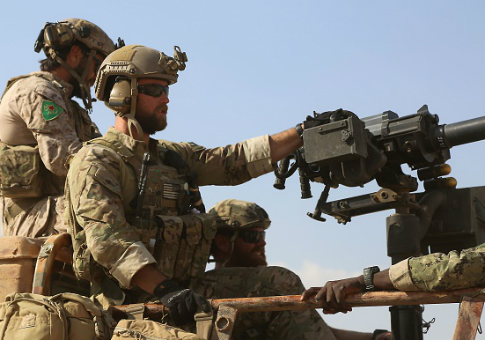The celebrity status of special operation forces (SOFs) after such high-profile successes as killing Osama bin Laden and rescuing hostages with near-miraculous precision, though lucrative for Hollywood, has proven a mixed blessing for the warriors; previously, keeping a low profile had been their modus operandi. Current notoriety notwithstanding, their status alongside the traditional military is unclear, as conventional methods of warfighting continue to dominate Pentagon thinking.
It wasn't always like this. As Hoover Institution Senior Fellow Thomas H. Henriksen illustrates in his excellent new book, Eyes, Ears & Daggers, SOF-style irregular warfare goes back to the Revolutionary War. It all started with Nathan Hale, whom he calls "the progenitor of the soldier-spy fusion that has become so noteworthy in the early twenty-first century conflict with jihadi terrorism." But it didn't take long for America to turn away from that model of warfare.
Indeed, our ancestors tried to forget about warfare altogether. The Founders had always hoped to get away from Europe's bloody battles and be left alone to build a prosperous city on a hill between two oceans. With the notable exception of Alexander Hamilton and some of his fellow Federalists, America's Founders were opposed to standing armies. So it should not surprise that America's irregular warfare and clandestine services are a relatively recent formation.
In fact, it wasn't until 9/11 that the CIA and special operations forces finally linked up, and it wasn't until 2012 that the Army clarified how SOFs fit into its organizational structure alongside other special missions like Civil Affairs and Psychological Operations. Even now, half a decade later, much remains to be done to incorporate the lessons learned from recent unconventional conflicts where SOFs have played a decidedly crucial role. A top priority is synchronizing military action across service branches, government agencies, and national boundaries, when our allies are involved. If that sounds like common sense, it is seldom followed in reality.
It seems that it took the tragedy of the Twin Towers for collaboration efforts to get underway. During the Clinton era, the national security apparatus responded tepidly, clumsily, and complacently to high-profile attacks by al Qaeda, including the 1993 bombing of the World Trade Center's Northern Tower and the 1998 bombings at the U.S. embassies in Kenya and Tanzania. As Henriksen points out, any observer of "behind-the-scenes counterterrorism deliberations [during the 1990s] must call out the glaring absence of close SOF-CIA interaction against the jihadi threat." That interaction would prove to be America's most effective hard-power instrument against terrorism, but until 9/11 it was missing in action.
The one budding seed of cooperation between the SFO-CIA during this period was the modestly named Crisis Response Team, established to strike terrorists on short notice. This cooperation would improve considerably as the need grew for rapidly organized covert operations to combat unconventional enemies. Clearly, these operations had to be informed by actionable intelligence. Neither was sufficient by itself.
Operational logic aside, one of the main rationales for using the SOF and CIA together is the complementary nature of their statutory authorizations. Specifically, the Joint Special Operations Command (JSOC) and the rest of the defense community operate under Title 50, which allows them to collect intelligence and mount covert action, and Title 10, which requires them to brief relevant congressional committees about their actions. The CIA's authority also derives from Title 50, but unlike the military it is permitted to run clandestine operations at the ultimate discretion of the president. Historically, these operations have been scrutinized less by Congress. Moreover, while the CIA can conduct operations in a foreign country without a formal declaration of war, the military cannot. This is the reason why the raid against bin Laden in Abbottabad, Pakistan, was conducted under the nominal charge of the CIA.
So smooth is the SFO-CIA symbiosis that the roles are often reversed, with military intelligence officials collecting information and civilian operatives at the CIA acting on that intelligence. In Yemen, for example, SFO-CIA teams had the surgical precision to attack al Qaeda terrorists while ignoring the country's Iran-backed Houthis rebels—a strategic priority of the Obama administration, which did not want to antagonize Iran.
Special operation forces are no magic bullet in the fight against terrorism, but they will continue to play a key role in U.S. counterterrorism efforts as long as the United States continues to emphasize the training of indigenous forces along with air strikes and special warfare tactics. As Henriksen correctly points out, this model reflects "Washington's reluctance to embrace a larger, more expensive game plan." But it cannot be enough. "The SOF-CIA weapon can hold terrorism at bay until the unlikely prospect that the Islamist fervor burns itself out before an unforeseen catastrophic event takes place. Or the United States and its allies can resolve to win the war against terrorism." In other words, the SOF-CIA approach, while effective as far as it goes, doesn't go very far.
It does, however, illustrate what is required for a strategy to be implemented successfully: Once the goal is established, the instruments to achieve it must be synchronized, no matter where they are in the organizational structure. Grand strategy requires not only whole-of-government but, in many ways, a whole-of-society effort.
National security should not be hostage to bureaucratic stovepipes and jurisdictional squabbles. The cooperation between SOF and CIA described in this book is a happy story of effective synchronization. But even the best weapon is only a tool. It is not a strategy.
